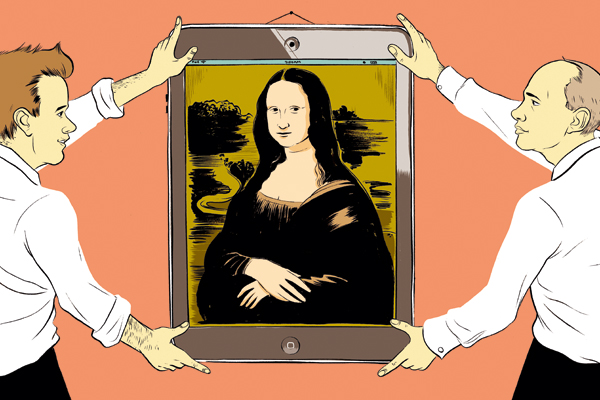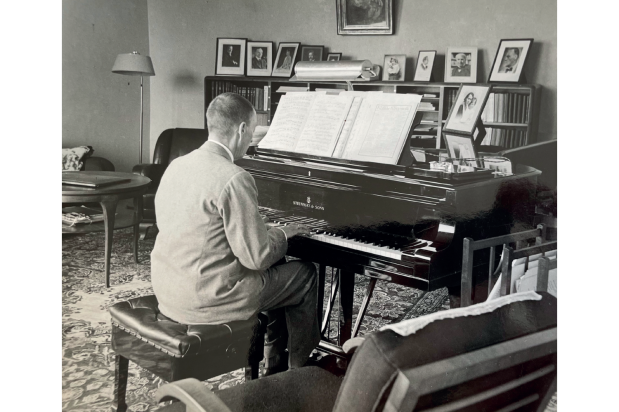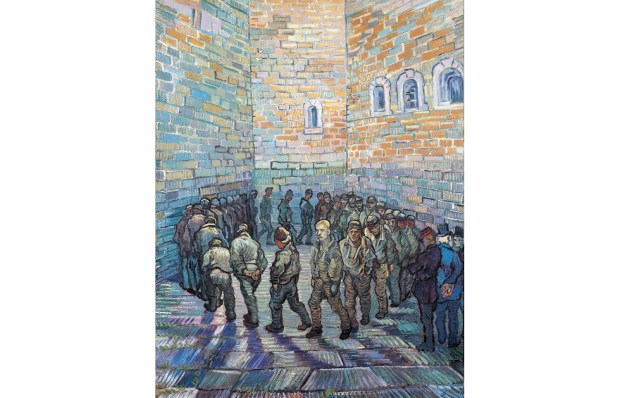The best way to view some of the world’s greatest works of art is to go nowhere near them. Like other celebrities, the most famous paintings are hard to get close to and there are few less spiritual experiences than being cattle-prodded as part of a crowd through an overpacked exhibition. You may visit in the hope of communing with legendary art but, as often as not, gallery-going is anti-contemplative.
While there is no way of replicating the experience of standing in front of a masterpiece, technology can at least allow you your personal space. Take Google Art Project, for example, a collaboration between the omnivorous internet search company and 151 museums, galleries and collections in 40 different countries. Using its Street View technology, viewers can ‘walk’ through the National Gallery, the Uffizi in Florence or the Met in New York and see what is on their walls. Some of the images are displayed at a resolution of one billion pixels: that means every bulge and hollow of paint, every stray hair or artist’s thumbprint is visible — far more can be seen on your computer screen in Thimpu, Bhutan than can be seen in situ, standing behind the guard rope. All without the jostling and the chatter of the galleries themselves.
That technology can be far less inimical to art than people is something our major art institutions have long grasped. The first audio guides came into use in 1952 at the Stedelijk Museum in Amsterdam, and now the National Gallery loans 135,000 of them each year. The National was also the first British gallery to set up a digital department and in 1991 it instigated a computer ‘micro gallery’ that allowed visitors not just to plan which pictures they wanted to see but also gave detailed information about them that couldn’t fit on the standard labels.
Technology has moved beyond the conservation departments that were its first home. For example, Paris’s ethnographical museum, the Musée du Quai Branly, has a new project to put various objects from the collection through a hospital scanner after hours when the patients have gone home. The resulting images are being used both by the conservation department and, after some 3D imaging jiggery-pokery, exhibited alongside the original objects to show what they are like on the inside as well as the outside.
According to Charlotte Sexton, head of digital media at the National Gallery, it is really since 2000 that an understanding of the wider possibilities of technology has taken hold. There is, she says, ‘incredible integration now — from publishing to sharing information, imaging the collection to storing it, accessing X-rays to buying prints … you couldn’t unpick it now’.
The defining word for all major collections these days is ‘access’. This does not just mean getting visitors through the doors but going global. Last year the National Gallery had some 5 million visitors, Tate Modern and Britain 5.3 million and 1.5 million respectively, and the British Museum 5.6 million. There is a limit as to how many people the buildings can hold. By digitising their collections the galleries can increase these figures exponentially and people who cannot travel to London themselves can still see the treasures. As Sexton puts it: ‘Our pictures have a real resonance out there.’ The figures back her up. Last year the National Gallery website had 6 million unique visitors.
The other word galleries love is ‘conversation’: they positively set out to encourage picture talk. Not only do they now have the requisite Facebook and Twitter presences (National Gallery 182,000 Facebook followers and 90,500 on Twitter; Tate Modern 900,000 Facebook and half a million Twitter) but they also utilise YouTube as well as their own websites for video presentations.
Jane Burton, head of content and creative director of Tate Media, has overseen a raft of new technological initiatives at the Tate galleries. ‘We are becoming our own production company,’ she says. ‘Professional grade kit is now cheaper, which allows us to become a broadcaster ourselves.’ Consequently, Tate has made its own short films for Channel 4, produced a video about the recent Roy Lichtenstein exhibition for the BBC, and a programme where Damien Hirst was interviewed by the comedian Noel Fielding that was aired on both television and online.
Tate has also pioneered the idea of ‘virtual’ exhibitions. Its online ‘Gallery of Lost Art’, featuring works that have been destroyed or somehow disappeared — from Marcel Duchamp to Rachel Whiteread’s East End palimpsest concrete house and Tracey Emin’s tent — has attracted 3.6 million viewers. Curiously the exhibition has been a big hit in Colombia, the home of drugs barons who, supposedly, have works of art stolen to order. In another initiative, BMW Tate Live, an artist is given carte blanche to ‘perform’ in a white room in the bowels of Tate Modern and the results are streamed live on YouTube for an invited audience that can then comment and ask questions. The National Gallery meanwhile recently hosted a talk between two of its curators on Google Hangouts, bringing an updated version of the expert lunchtime talk to anyone in the world.
Galleries are also as addicted to smartphones as the rest of the world. As Sexton says: ‘Devices may have changed but people haven’t’ (she is ‘keeping an eye’ on Google Goggles). ‘We ask, “What do you want on the move?”’ The answer is always information because, she points out, the majority of visitors ‘need support and assistance to understand what they’re looking at’. One way to do this is through apps. The Tate has 14 of them, including the ‘Magic Tate Ball’ where you shake your iPhone and up pops a work of art appropriate not just to the place where you find yourself but the time and weather too (125,000 downloads so far). Another way is to allow audio guides to be downloaded on to smartphones, which can then also offer extra information in the form of video clips and other imagery.
The National Gallery is currently working on a scheme to put wifi into the building so, before long, visitors will be able to see the paintings while simultaneously listening to their smartphone audio guide, tweeting about the experience, updating their Facebook status (‘Baroque art at the NG — it’s complicated’) and adding a bit of web surfing for good measure.
Older technologies are being used in new ways too. A film of the Royal Academy’s recent Manet exhibition, for example, was shown in 1,000 cinemas in 32 different countries, and Munch 150, celebrating the gloomy Norwegian’s 150th birthday, went out earlier this month; the National Gallery’s Vermeer and Music will follow. The National is also taking a ‘cinema truck’ around an assortment of summer festivals to show films about its Titians.
Technology in galleries has proved to be what Sexton calls ‘a quiet revolution. A whole generation can’t imagine life without it.’ There is a certain neatness in encouraging the art-interested public to take the ‘longer look’ by using the very techniques so beloved of those with a short attention span.
Got something to add? Join the discussion and comment below.
Get 10 issues for just $10
Subscribe to The Spectator Australia today for the next 10 magazine issues, plus full online access, for just $10.
You might disagree with half of it, but you’ll enjoy reading all of it. Try your first month for free, then just $2 a week for the remainder of your first year.














Comments
Don't miss out
Join the conversation with other Spectator Australia readers. Subscribe to leave a comment.
SUBSCRIBEAlready a subscriber? Log in